#1893 Map of the Seat of War
Text
The Draining of Allapattah Flats-C-23
Recently I wrote a post entitled: “Learning the Beauty of Pre-Drainage Lands – St Lucie Canal.” One of the most prevalent natural features asked about is “Allapattah Flats.” I recall hearing the mysterious words “Allapattah Flats” while growing up in Martin County. Now, almost 60 years later, I recognize I really do not know what they were…
Page 1, EDD 1915 St Lucie Canal Survey Lake Okeechobee…

View On WordPress
#"Griscom Bettle&039;s Allapattah Ranch Has 4#"Map of the Seat of War in Florida#000 Acres Under Water Control#1893 Map of the Seat of War#Al-Pa-ti-o-kee Swamp#Allapattah Flats#Allapattah Ranch#and clay soils -shells and marl deposits- once an ancient seabed.#C-23 drainage#C-23 Ernest Lyons#C23#Ecosummary C-23#Lush Grass on Marin Highway."#map Florida 1839#Muck#pine ridge#sand#serrated by maiden cane sloughs#The Draining of Allapattah Flats-C-23#Z. Taylor map
0 notes
Note
A dime for your thoughts, try to explain the entire vK fan-family as if I'm a stranger. Also pls tell me about random headcanons you have for each and every member (if you wanna).
alright, have a seat. i don't have presentation panels, because I am too lazy for that. maybe eventually.
At some point in history (around 1860) a savvy Austrian entrepreneur Erster Bauer decided to take his trade up to the next level and travelled to Japan where he had many adventures nobody back in Europe would ever, including getting almost killed by local wildlife and promptly rescued by a member of the Asogi swordsmanship tradition. This impressed our guy so much that he wanted to show it the Japanese way and went fully "Hey, what's your sword called? My family will bear its name forever!" Europe has a long tradition of inventing names and terms by misspelling the old ones, so our merchant-adventurer went down in history as the first ever von Karma, causing several geographers trying to pinpoint Karma on the map.
So the entire von Karma family is this one guys fault, but he hadn't fucked up yet.
Erster von Karma, as the dude was called, got moderately wealthy in his business and upon his return to Europe he figured he's had enough of adventure for three lifetimes and he started a family. Since he was a bit of megalomaniac ass, his wife didn't really stay around, but he got to keep the only child that survived into adulthood: Frieda.
Frieda von Karma was a daughter of many expectations and pushed limits. Born 1893 she had managed to finish her art studies in Vienna before the WW1 managed to rolled around. She had moved from Austria to the newly founded Germany (Bavaria specifically) after the first war where she opened an art gallery (which served as her home) and worked as a renowned art critic. The gallery did not survive the Nazi party and its successor did not get as famous or profitable, nevertheless Frieda managed to set her family well off financially for generations. What is today known as the Gallery Hall in the house features mostly her artwork, most prominent being the row of portraits of family members.
She married Bernard von Karma (because the man could not pass up the opportunity to get a "von" in his name), a civic engineer who had taken it upon himself to improve their home as much as possible. His combined love for secret passages and "alternative approach" to electricity grounding had effectively booby trapped the entire mansion, which resulted in a) the subsequent generations of von Karmalings to be extremely and acutely aware of their surrounding at any given time, b) no burglary attempt at the von Karma estate had ever been successful, there is even a record from 1938 of a thief who called for help and promised to surrender to the police if he was safely led out of the house.
Their oldest son Herman von Karma was raised very strictly and "shaped to perfection", as Frieda had no lesser expectations of her children than she had of herself. He was sent to study abroad, first in Great Britain, later to the United States, and he had never truly returned to his home country, as he remained across the Atlantic as a part of the diplomatic ensemble. In fact he frequently described his brief visits to Germany as being a stranger in his homeland. He was rather a temperamental man and the several politically motivated assassination attempts on his life did absolutely nothing to ease his growing paranoia. He was quite the shot, reportedly, and several wannabe assailants learned the hard way that he knew a lot both about anatomy and how to wield an improvised melee weapon. The bodies had been found many years later after his death during the garden renovations of the von Karma mansion in the US.
Their younger son Siegfried von Karma seemed to be the promising exemplary child much like his older brother, but where Herman studied at Oxford, Siegfried studied at Aberdeen and became far too influenced by the style of Scottish Highlanders. His love of fencing and finished studies of natural sciences made him a valued police investigator. After sustaining severe injuries he was forcibly retired and he returned to Germany, where his retirement did not apply. There he teamed up with forensic expert Saikoll Edgich and they later published a comprehensive overview of their co-joined investigative methodologies in the Psychology of Murder and the Murder of Psychology which proceeded to be of great help to many people who had to solve a homicide without much tangible evidence, although it had never made it to become a textbook. Its authors, however, had a growing resentment between which resulted in an ugly confrontation which Edgich by an accident did not survive. Due to Siegfried’s less uptight and more free-minded nature causing him to clash with his mother Frieda harshly in later years, he and his family lived in a separate wing at the von Karma estate, known also as the Thistle Wing. After his mother’s death it was him who cared for the estate as who, as Herman rarely visited.
Herman somehow found the time to marry and produce three children, but he had very little time to actually raise them. For that reason his oldest son Friedrich von Karma spent his early years under the iron hand of his grandmother Frieda. In his mid-teens when he was “no longer to be such trouble” he was moved to live with his father in the US, which he thought would be a relief. He was wrong. For details, though, you should ask @infamouslydorky, because ultimately she is the idea-parent of Friedrich. What’s for certain is that Friedrich became a career politician, probably partially inspired and partially pressured into by his father, and that his hair is absolutely everywhere, since he has so much of it. He did not marry and does not have any children (that he knows of).
Friedrich’s younger brother Manfred von Karma was also brought up in Germany by Frieda and had the unfortunate trait of not appreciating standing mdoel to her, so he was the less favoured child. As such he got compared to his uncle Siegfried a lot, which culminated in his decision to also pursue a career in law, ultimately making him the most feared prosecutor both in the United States and the half of Europe he deemed worthy of visit. In the long term his instilled perfectionism lead to only his wife Ilona von Karma being able to put up with him, and also to him killing a defense attorney who broke his perfect trial streak by securing him a court penalty. Being the epitome of mental health, he also took care of (though did not adopt) said attorney’s orphaned son, and had a bullet in his right shoulder for 15 years, which eventually got him convicted of the murder he had committed. The entire family prefers not to talk about the whole incident.
Griselda von Karma is the youngest of Herman’s children, and unlike her brothers she had never really spent any time under her father’s influence, so she turned to be Frieda’s perfect granddaughter. Appreciative of arts of all kind, she was mostly drawn towards books. Gaining Masters in history at the mature age of 14 she began a successful career as an archivist and well renowned book critic. She added the extensive library to the von Karma estate, though a large part of it contains rare and prized books, therefore being off limits to majority of the people, family included. She has failed to have children, because she hates loud noises.
Wolfgang von Karma is the older son of Siegfried (if you remember him) and adored his grandmother’s art greatly. Unfortunately his Father was the family’s black sheep, so he did not get introduced to the secret world of oil pains and temperas, so he turned towards photography. He is, technically, a studied chemist, but besides developing his photographs he had never really worked in any field resembling chemistry at all. His brief adventure with textile dyes at university introduced him to the Weber sisters at the textile factory, who in turn introduced him to punch cards which set off his entire career as one of the pioneers programmers. He married the youngest of the Weber triplets Nadele von Karma, but he’s kept a close relationship with her sisters too. With their help he keeps the the large pack of various dogs, making it very easy for little von Karmalings to get a puppy. He has a reputation of being uncharacteristically easy-going for being a von Karma
His younger and more ambitious brother is Markov von Karma in whom is dangerously combined Frieda’s over-achieving perfectionist upbringing and Siegfried’s love to fight. From early on he’s sat on career of an investigative journalist, first couple of years he had followed his father alongside his investigations, eventually he eloped across the world on his own. He also frequently participates in fencing and swordsmanship competition, although he had be banned from several of them for his conviction that he had gotten from Siegfried that a good swordsman is the alive one, not the one that refuses to hit his opponent with a chair. Markov keeps minimal contact with his family and adamantly refuses to show up to any family gatherings. The von Karmas know he is alive only because of the meticulously arriving birthday postcards, the occasional article signed MvK, and the rare call from Wolfgang who uses his younger brother instead of Wikipedia. He has married his editor Edith Vin Korek for tax benefits and healthcare insurance. Despite Edith living in Los Angeles where the US family estate is, they’ve managed to keep the marriage secret (or rather they did not bother informing anyone).
Manfred’s oldest daughter, Helena von Karma, spent the first five years of her life with her mother in Germany where Ilona cared for Frieda to whom age had not been kind. After Frieda’s passing they both returned to the States, where Mafred tried and subsequently failed to be a present and attentive father. Helena expressed her wish to study law in Germany, thus returning to the family estate once again which was now in the far more liberate care of Siegfried who deliberately ignored Aurelia’s desire for upkeeping his mother’s restrictions. Upon passing her bar exam at the age of sixteen, Helena continued to practide law as a prosecutor in Germany, Austria, and eventually Switzerland where she married her court rival Arnborg Prouvele-von Karma. Upon the birth of their first child they agreed to raise the girl as far away from family shenanigans as possible and moved to Canada, which ultimately turned out not to be far enough.
Leonore von Karma is Manfred’s second daughter. you tell me, Ly, what’s going on with Leonore, because I’ve gotten kinda lost. However, she is the first fortunate child not to meet Frieda von Karma and her fierce pervasive perfectionism, so she might have gotten a breather.
The youngest of Manfred’s children is Franziska von Karma, who unlike her older siblings had the luxury of spending her early childhood years with her father, but at the cost of her mother’s passing within her 3rd year of life. Much like Helena she was a law prodigy and followed her father’s footsteps to become a prosecutor. She studied international distance courses and passed her bar exams in Germany at 13 years of age. Since that was where she lived (now without father) over the course of her studies, her pre-teens were overseen by Griselda and Siegfried, who for an unfathomable reason thought that gifting a 9 years old girl with weapons was a good idea, and it is a miracle that she settled for crop and whip and not a flail. After the shocking conviction of her father, Franziska had spent a very self-destructive year trying to prove herself better then everyone, especially her (supposedly deceased) adopted brother, and after that went on a little soul-searching work-trip across the world. Now she works closely with Interpol and is doing her very best not to turn into another iteration of her aunt or great-grandmother.
Gandulf von Karma is Wolfgang’s only son who has never had any ambition to travel. He graduated suma cum laude physics and engineering at 17 and got himself promptly hired as an assistant at German Aerospace Center. In addition to that he’s used to serve as a consultant for several sci-fi productions, but he quickly abandoned that line of work when he found out that it meant talking to “actual people” and not just engineers. Most of his free time he spends helping his three mums with training the dogs for competitions. At some point in his life he’s gotten married to Katzcherine von Karma and even had children with her, but he has no idea how or when that happened. Both parties are quite certain it was an accident, thus they divorced fairly soon after someone reminded them it was an option.
Nikolle von Karma is so far the only daughter of Helena. While she is decided to also become a lawyer, she isn’t so sure about being a prosecutor, but she keeps her options open, because auntie Franziska has made a very good impression. She is currently living in Canada with her parents and is trying to soften up her mother to also let her have a whip. So far it seems that her two dogs Unicorn and Bigger Phoenix will have to do to protect her.
Ilse von Karma is the Gandulf’s firstborn. Her promising early earned degree in several languages is used solely to yell responsibility even into those members of family who pretended not to understand German and English. With grandfather Siegfried being of advanced age, Griselda attempting to claim the role of the iron ruling matriarch, and Gundalf barely being aware where he left his shoes, it is now Ilse who is de facto running the estate.
Jörgun von Karma is Gandulf’s second child. His plan is to become a politician. Being too young for it at the moment, he is chasing a politology degree, and also every skirt he sees. He also pursues classical ballroom dancing and has already won several competitions.
Youngest of Gandulf’s children is Gretchen von Karma who is living in the childhood fantasy of being a princess and is playing a matchmaker to everyone she meets.
with this I’ve exhausted the list. Headcanons some other day, this is too long already
6 notes
·
View notes
Text
I’ve Made A Huge Mistake {4/?}
Peter Parker x Reader, Quentin Beck x Reader
Summary: Peter just wanted to enjoy his trip to Europe, maybe even confess his feelings to his best friends.But along came a mysterious new hero to ruin those plans. Peter and his class are aged up and in college.
Warnings: Violence in later chapters, manipulation, age gap
Word Count: 1893
Series Masterlist
Main Masterlist
The holiday became a whole lot less fun overnight. Originally it was meant to be a break for Peter, away from being a superhero, away from avenging, away from all his responsibilities. But, like always, some otherworldly being came and fucked that all up for him. And Peter was supposed to confess his feelings for her in some romantic candle-lit restaurant in Venice, or at the top of the Eiffel Tower. But Beck came along, swept her off her feet and fucked that all up for him. Even though Fury had said he didn’t have to join the mission, Peter knew, in the back of his head, that some way or somehow he would get dragged into the situation again. There would be another world-ending threat that would inevitably pop up in another city, one that Peter couldn’t ignore.
The two of them returned from Fury’s base in the early hours of the morning. She was incredibly giddy, a grin plastered across her face for the whole journey. He’d seen her get like this before, the time her 8th-grade crush asked her to the winter dance, or when Peter scored them tickets to a Star Wars premiere. It was the most beautiful expression Peter could ever be graced with - when he caused it he felt on top of the world, when another guy caused it he fell into a pit of jealousy. He tried his best to be happy for her, she was over the moon, Beck seemed like a good guy. He didn’t control her, he had no right to dictate who she could and couldn’t date. But he just couldn’t, he could never feel content if she was with someone else. So he let her talk about this perfect guy, acknowledging her ramblings just enough to not be rude: because that’s what a best friend does. And he’d rather be her friend than be nothing at all.
“Are you sure you’re good?” Peter asked Ned the next morning as they waited for the bus.
“Seriously, don’t worry, getting tranqued by Nick Fury is probably the coolest thing to ever happen to me.” Ned reassured him, way too positive about getting knocked out. Peter laughed nervously at his response.
“I’m just happy I don��t have to go to Prague.” Peter said as they absentmindedly did their handshake.
“Good news,” Mr Harrington said, bursting out of the hotel door, “we’re going to Prague.” He announced.
“Prague?” Peter asked, along with a few of the other students. Of course Fury would interfere.
“Yeah, tour company upgraded us. You should've heard me on the phone with them. I really gave them hell. All I heard was crying.” The teacher continued as a much bigger, sleeker black bus turned the corner. “Look, our upgraded ride.”
“Peter, what’s going on?”
“I think Nick Fury just hijacked our vacation.” One of the agents Peter saw last night stood outside the bus, purposely ignoring Mr Harrington’s feeble attempts at an introduction.
Once the group was on the bus Peter pulled out the case Fury gave him the night before. He opened it to reveal a pair of glasses, identical to the ones Mr Stark used to wear. Peter stared at them, unsure whether to feel happy at the sight of them or to burst into tears over his late-mentor. A note on the front read ‘For the next Tony Stark, say EDITH’. He read it aloud as he placed them on his face.
“Stand by for a retinal and biometric scan.” The glasses lit up. Peter watched curiously as a model of his face appeared in front of his eyes. “Scan accepted.”
“Hello?” Peter asked, a series of questions filling his head.
“Hello, Peter. I am EDITH, Tony Stark's augmented-reality security and defence system. I have access to all of Tony's protocols.” The AI explained.
“Cool.” Really Peter, he thought to himself, even with all the questions spirling in his mind all he could say was cool.
“Would you like to see what I can do? EDITH stands for “Even dead, I’m the hero.” Tony loves his acronyms.”
“Yeah, he did.” Peter laughed affectionately. At least he could have this link to the late, great Iron Man.
“I have access to the entire Stark Global Security network including multiple defence satellites as well as back doors to all major telecommunication networks.” She continued to fill him in. Peter glanced around the bus, multiple views of people’s phone screens popping up. It ranged from students begging their parents for more money to Mr Dell searching up witchcraft. So much for science professors.
“Is she texting Beck?” Peter asked before he fully realised what he was saying, “no, no, that wrong.” He said, sinking down into his seat. He had to respect her potential relationship, no matter how much it pained him. Out of the corner of his eye, he saw Betty and Ned sat next to each other, repeatedly texting ‘I miss you’ to each other. He grimaced at how completely cliche they were. The bus soon pulled into a village centre, allowing a quick toilet break. Flash left first, filming a video as he continued his attempts for insta fame. Peter got off last, only being able to step off the bus before he was stopped and instructed to go into a building opposite from him. Inside stood a tall blonde woman dressed near-identically to the agent driving their bus.
“Hi, I’m Peter.” He introduced himself nervously.
“Close the door.” She said firmly, her Eastern-European accent thick. He turned, immediately obeying her, honestly slightly intimidated by her. “Take off your clothes.”
“Excuse me.” Not exactly where he had expected that to go.
“You told Fury Spider-Man cannot be seen in Europe. So I made you this, another suit.” She handed him an all-black suit.
“Um, thanks. I’m sure it fits fine.” He replied awkwardly.
“Take off your clothes.” She said bluntly.
“Okay,” He whispered, unzipping his pants and pulling them down, “this is embarrassing.” He tried to alleviate some of the tension. Suddenly Flash walked into the building. His face went pale, scared he would assume the worst.
“Damn Parker, you got a hooker, didn’t think you had it in you.” Flash joked, taking a picture of the scene in front of him before walking back outside. The woman pulls out a gun, aiming it carefully at the back of Flash’s head.
“No, no, no, please don’t shoot,” Peter said in a panic as he made the agent lower her gun. “I’ll sort it out.” He grabbed the new suit, and ran out of the building, pulling his pants back up as he did so. “Flash, Flash, stop!”
“Honestly Parker, I can’t tell if I should make fun of you or congratulate you. That takes a lot of balls.” He continued to laugh.
“That, that wasn’t what it looked like.”
“Then what was it?” Peter opened his mouth, attempting to respond, but nothing came out. He ended up opening it and closing it over and over again, looking like some fish stuck on the land.
“Exactly.” Flash replied, walking towards the bus, “Wait,” he turned back, a smirk on his face, “What do you think she’d think about this?”
“What do you mean?” Peter asked cautiously.
“That her best friend, little Penis Parker, is secretly a perv.” Flash smiled as somehow more colour drained from his face. “Bet she’d love that.” He said, stepping onto the bus. Peter panicked, running back to his seat and shoving EDITH onto his face.
“Hey Peter, how can I help you?” Peter began to mumble an explanation, “I’m having difficulty hearing.” EDITH responded.
“There’s this guy, Flash Thompson, he’s got this photo of me and -”
“Is Flash Thompson a target?”
“A target?” Peter turned to see Flash, he had the picture up, ready to send the photo to the rest of his class. He knew he could tell her the truth about the situation, she’d understand, but still, he wanted to keep her from seeing it. “Yeah, he’s a target.”
“Target confirmed, initiating strike.”
“Initiating what now?” Peter asked, sitting up slightly straighter in his seat. Peter watched a map appear in front of his eyes showing an attack drone being released from a Stark satellite. “Shit.” He immediately stood up, out of his seat. He made his way over to where Flash was sat, all while keeping an eye on the ever-nearing drone.
“Cool glasses Parker,” Flash said, grabbing them off Peter’s face, “when d’you become so rich.”
“Flash, please, give ‘em back.” Peter went to take them back but Flash kept batting his hands away. “Flash, I’m serious.” He said, going for Flash’s face, accidentally knocking him out in the process. Peter stepped back, shocked. Sometimes he forgot his own strength. He brushed it off, sliding the glasses back onto his face. “I’m so sorry, EDITH don’t kill Flash.”
“Peter do you want me to call off the drone strike on Flash.” The AI asked.
“Did you just punch Flash?” A classmate asked at the same time.
“No.” Peter answered quickly. But EDITH had mistaken that for him answering her question.
“He’s knocked out.” Another shouted.
“Look, baby mountain goats.” Peter pointed out the window, successfully distracting the group. As the drone went to fire Peter jumped up, pushing through the roof window, shooting his webs out. Luckily for him enough were caught on the drone to disable it, making it crash down the mountain beside them. He landed, terrified anyone saw what he’d just done and how close he’d come to killing a classmate.
“Peter, I know you think we haven’t noticed,” Betty began causing Peter’s eyes to widen, “but your new look, I love it. Right babe?”
“Yeah, it’s super classy.” Ned agreed. Peter let out a sigh of relief, collapsing into a seat next to his other best friend.
“What the hell was that?” She scolded him before he could properly relax.
“I may or may not have almost killed Flash.” He was slightly worried that he had pissed her off as she continued to stare dumbfoundedly at him. Soon he was reassured by her bursting out laughing.
“You’re a fucking idiot Peter.”
“Well, you know -”
“No, no, you are genuinely the biggest dumbass I’ve ever met. How did you ever do that?”
“Um, these,” He took off the glasses, handing them to her, “they’re what Mr Stark gave me. Turns out saying someone's target sets a military level drones on them.” She couldn’t stop laughing. “I’m sure he’d be real proud of me.”
“Don’t,” Her voice turned more serious, “he obviously trusted and believed in you so much. And he’s hardly someone who never made mistakes. He’s the least perfect avenger, and still, he achieved more than anyone else in the world could even dream of. He would’ve expected to make hundreds of mistake and fuck up time and time again. But he wouldn’t have given you these if he think you could clean up all those messes.”
“Thanks.” He whispered a slight confidence boost after that little speech.
“I’m serious,” she said, resting her head on his shoulder, “you’re pretty fucking awesome Parker.” And there was the ego boost. They stayed there in comfortable silence for a while, both perfectly content. Not long after she began to uncontrollably laugh again. “You almost killed Flash fucking Thompson.”
@cool-ontherun-world
@eleventhdoctorsangel
@chubby-tink
@eridanuswave
#peter parker#peter parker x reader#peter parker imagine#peter parker x you#peter parker x original character#quentin beck#quentin beck x you#quentin beck x reader#quentin beck imagine#marvel fic#ive made a huge mistake#mysterio x reader#mysterio#mysterio imagine#spiderman#spiderman far from home
98 notes
·
View notes
Text
THE THEATRE OF POMPEY, Pt. 1

Pompey the Great began to build the first permanent theatre in Rome over the years c. 61/55 BC. The construction of the immense theatre coincided with the first triumvirate, the renewal of which at Lucca in 56 BC paved the way for Pompey’s second consulship, with Crassus, in 55 BC and his governorship of Spain.

Almost every aspect of the building--its location, form, scale, function--was determined by political considerations. Pompey himself conceived of the theatre as an never-ending triumph, perpetuating the memory of his brilliant career, as a venue for his political activities, and as a sign of his taste and admiration of Hellenic culture. First and foremost, however, he conceived of the building as a massive bribe designed to buy the support to the common people at a critical moment in a high-stakes power struggle.

The vast complex had a long-term significance as well. It transformed the course of Roman architecture, serving as the architectural model for subsequent theatres and as the patronage model for the large-scale, public commissions undertaken by the emperors.
The theatre of Pompey was an amalgamation of buildings with varied and sometimes interrelated functions. The theatre, or entertainment portion, was modeled on the Hellenistic theatre at Mytilene, which Pompey visited in 62 BC, but executed on a much larger scale. The three-story, 90 meter-wide scenae frons was able to accommodate 600 donkeys trotted on stage simultaneously during the performance of play. Pliny estimated the seating capacity at 40,000, which was dismissed for centuries as exaggeration, but has been confirmed by recent excavations.
As the donkeys suggest, a theatre of this size could accommodate a wider range of entertainments than the typical Greek theatre. Cicero’s account of the open days of the theatre mentions not only recherché Latin and Oscan dramas and dramatic readings by famous retired actors, but athletic competitions and gladiatorial combats as well (venationes several days in length were carried out in the nearby Circus Flaminius). Like the amphiteatre of Pompeii, Pompey’s cavea was shaded by a velarium; The cavea was also cooled by water flowing through channels cut into the stone floor.

The religious component, a small temple of Venus Victrix, to whom Pompey attributed his victories, was placed at the top of the cavea, which served as the temple’s podium and staircase. This arrangement was not unprecedented: the hemicycle temple at the summit of the sanctuary of Fortuna Primagenia in Praeneste (seen below) was approached by a semi-circular staircase which doubled as theatre seating. The temple was completed three years after the opening of the theatre. Several smaller shrines dedicated to Virtue, Felicitas, and Honor were located in the theatre.

Abutting the back of the scenae frons was an immense porticus pone scaenam, the building’s social component. Pompey’s porticus differed considerably from the practical storage facility and shelter later codified by Vitruvius. The Severan Forma Urbis indicates a vast, enclosed, peristyle garden, planted with rows of plane trees interspersed with fountains and pedestal statuary chosen by Titus Pompilius Atticus (which may have included the 6-meter gilded bronze statue of Hercules discovered during excavations in 1865). Additional amenities included a gallery, dedicated to the display of Pompey’s war spoils. The garden quickly became a popular meeting place and a prototype for numerous enclosed parks in Rome. The two long covered pavilions seen in Gismondi’s plastico are not supported by archæological evidence.
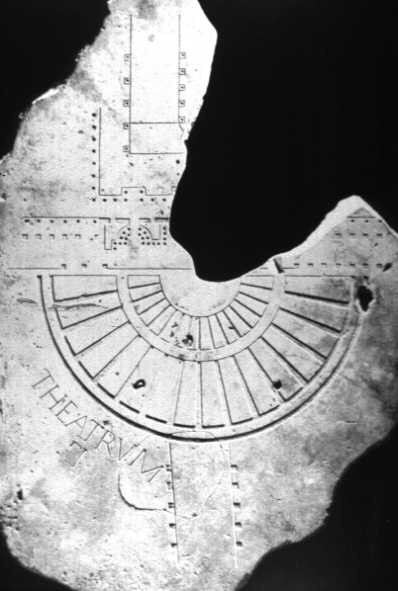

Finally, a curia, or meeting place for the senate, the building’s political component, was built into an exedra at the eastern end of the porticus. It was in the curia pompeia, and not the curia hostilia in the Roman Forum, that Julius Caesar was assassinated in 44 BC. Jean-Léon Gérôme’s painting of Caesar’s assassins (1859/67) recreates the curia as it was understood by 19th-century archæology.
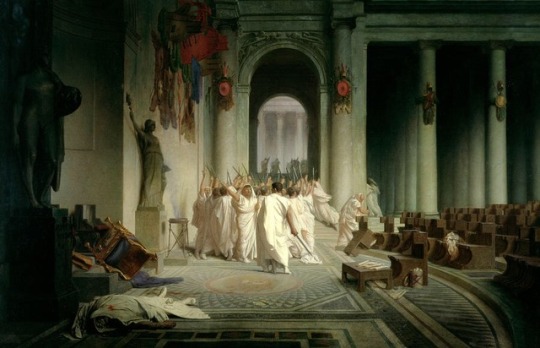
The walls of the theatre and portico were composed of traditional travertine masonry, while the innovative system of vaults and arches that supported the cavea were composed of concrete. The red granite engaged columns and blind arches that made up the three tiers of arcades of the exterior elevation were purely decorative, serving no supporting function. The use of a concrete substructure to support the cavea made it possible for Pompey to choose a location on flat land in the center of Rome.

Covering what s now an entire neighborhood, the theatre of Pompey extended from the Campo de’ Fiori to the Largo Argentina area sacra—a distance of approximately 500 meters. The Flavian Amphitheatre, by contrast, is 189 meters in length. If it were still standing, the theatre would tower over every other structure in the vicinity, including the church of Sant’ Andrea della Valle. The first theatrum lapideum in Rome was the largest theatre ever built in antiquity and the most impressive public building in the city, surpassed in scale only by the Domus Aurea in the next century.
1. Italo Gimondi, Topographical Map of Ancient Rome, Rome, Museo della Civiltà Romana.
2. Victoire Baltard, Section of Theatre of Pompey Cavea,
3. 3D Rendering of the cavea.
4. Reconstruction drawing of the cavea and temple.
5. 3D rendering of the temple of Fortuna at the Sanctuary of Fortuna Primagenia, Praeneste.
6. Severan Forma Urbis, c. AD 205, Rome, Archivio Storico Capitolino.
7. Rodolfo Lanciani, Forma Urbis Romae, Pl. XXI, 1893/1901.
8. Jean-Léon Gérôme, Assassination of Julius Caesar, 1859/67, Baltimore, Walters Art Gallery.
9. Reconstruction drawing, 1915.
10. Google Earth view of area of modern Rome where the theatre was located.

#roman architecture#gnaeus pompeius magnus#porticus pompeianae#roman gardens#julius caesar#classical antiquity#mytilene#rodolfo lanciani
6 notes
·
View notes
Text
Musée d'Orsay & Musée de l'Orangerie
26/04/2018: Toast, coffee and tea for breakfast this morning. To avoid the old French woman, who didn't appear again, we quickly and quietly exited the building and headed to the corner. Today we were looking to visiting the Musée d'Orsay, across the Seine and Musée de l'Orangerie, at the end of Jardins Tuileries. The easiest way to get there was to cross the road at Rue de Castiglione, down the stairs protected by the beasts, and across the gardens along Allée de Castiglione. The footbridge, Léopold Sedar Senghor got us just about to the front door. The Orsay didn't open until nine thirty so we didn't leave the apartment until nine and after advice from the security dudes out front, queued towards the back of the forecourt.

Rhinocéros attaqué par un tigre. One of the beasts
Once the site of the Orsay Railway Station, built for the Universal Exposition of 1900, the building was saved from the wrecking ball by a revival of nineteenth century architecture during the seventies. The station and its hotel's usefulness diminished after the Second World War as the platforms became too short as modern trains become longer. Electrification didn't help neither. It subsequently serviced the shorter suburban trains until its final demise.
An itch in its daddy's pants during the early seventies, Direction des Musées de France officially hatched the museum idea and listed the building on the Supplementary Inventory of Historical Monuments not long after. Musée d'Orsay was officially given the go ahead in 1977 and classified a Historical Monument the following year. The new museum was inaugurated by François Mitterrand at the end of 1986 and is now dedicated to displaying collections of art from the period 1848 to 1914.
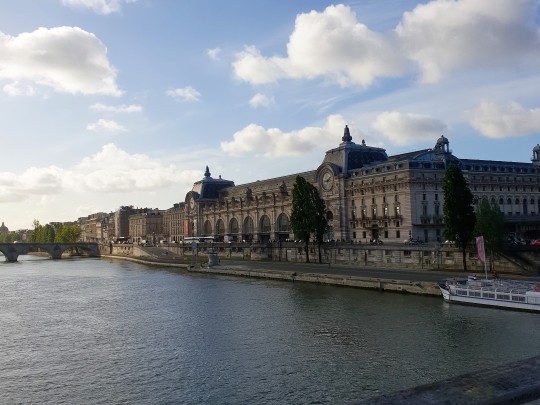
Musée d'Orsay
Studying the gallery map from the concierge, we looked for the lifts that would take us straight to the top and the temporary exhibition of the Neo-Impressionists. The boys took the stairs while the girls took the elevator. Since we were not keeping in contact at that point the girls went on their own tour of the gallery. They saw pretty much what the boys saw but in a different order. The following is how the boys tour of the gallery panned out.
Studying the gallery map from the concierge, we looked for the lifts that would take us straight to the top and the temporary exhibition of the Neo-Impressionists. The lift serviced several floors above the entrance which opened up to the intermediate floors along the main concourse's flanks. That’s where we separated. Being at the top gave us a good perspective of what was ahead. Looking through the braced iron frame and down the length of the building where the platforms and railway tracks once stood. Now covered by great works of art from the more recent periods of history.

Looking down the old concourse
Interesting first impressions. We were on Level 5 and the paintings in the first Temporary Exhibition, in Salle 36, were just dots of colour, but very good. The founders of the Neo-Impressionist movement, Georges Seurat and Paul Signac were a part of a new generation of creative artists who, during the eighties, championed the scientific art form born from the triumph of Positivism. Furthermore, they developed a technique of painting in very small dots, not unlike our indigenous Aussies back home. But these guys decomposed the work and managed to make the colours vibrate, by juxtaposing complimentary shades and modulating colours to achieve a particular luminosity. It's true, it worked. When we stood back to admire the painting, the orientation of the lines and the spatial arrangement of the planes contributed to the overall harmony and we could recompose the picture. Just as the sign said. The Neo-Impressionists were very impressive.

L'Air du soir, 1893 (The evening air). Henri-Edmond Cross

L'homme a la barre, 1892 (Man at the Helm). Théo van Rysselberghe
Moving through the corridors led us to the next section, Salles 35 down to 29 with the first room mostly dedicated to Auguste Renoir and Paul Cézanne, Impressionist and Post-Impressionist painters respectively. Renoir, apparently from the school of those who painted beauty and feminine sensuality, had plenty on nakedness in his pictures, and few men. Cézanne on the other hand, except for his Bathers series, painted mostly landscapes and clothed people in social gatherings. Salle 34 was full of Monet. Women in boats, plenty of flowers and a few goes at the Cathedral of Rouen filled this room, and of course one of his many paintings of haystacks. We guessed that each haystack gave him a different perspective than the last. Then a small room for Degas. Salle 33 had not much more than a half dozen bronze statues of horses and women.
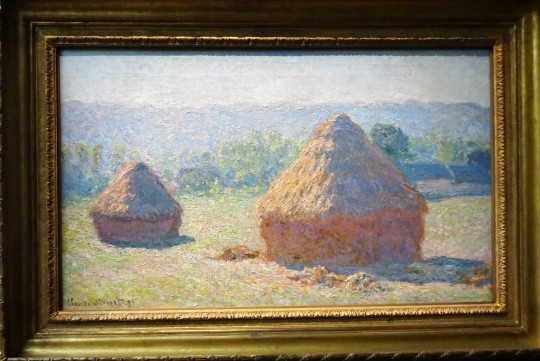
Stacks and stacks of Haystacks
The next room was quite large and was shared with some well known artists. Quite a few Pissaro, the odd Sisley and more Renoir and Monet. Degas and Renoir appeared in Salle 31 with plenty of Degas' ballet and dancing pictures and figures. The rest of Level 5 was more of the same, they all shared the remaining rooms but it was mostly the Monet and Manet show.
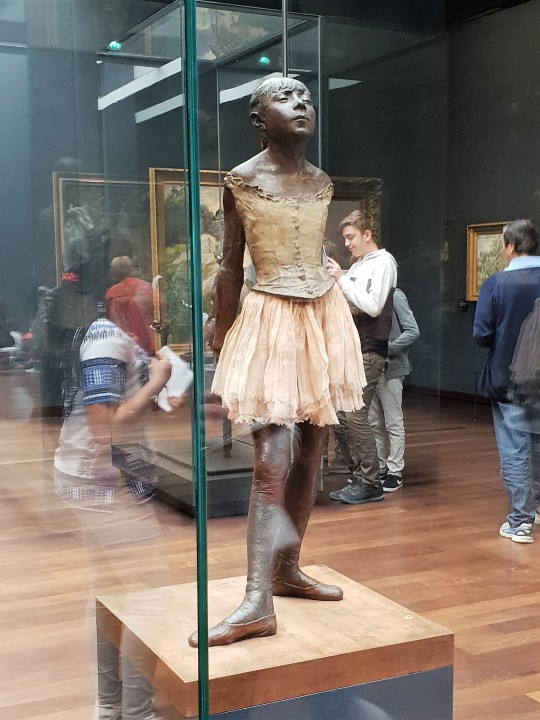
Petite danseuse de quatorze ans. Edgar Degas
Dropping down three floors to Level 2, Levels 4 and 5 were off limits for some reason, administration maybe, the Salles were in their sixties. A large mezzanine floor overlooking the concourse or le Allée centrale des sculptures was full of sculptures and linked the rooms that held a mixture of vases, goblets and more antique like stuff with the most magnificent collection of Art Nouveau Decorative Arts, or what you and we would call furniture. This area was great. The style of the beds, dressing tables, benches, entrances and so on were out there for the age but soon adopted by the French. Designers of today could take a leaf out of the Art Nouveau movement’s book. Maybe we're too conservative.

Nénuphars, Louis Majorelle

Banquette de fumoir (Bench for a Smoking Parlour), 1897. Hector Guimard
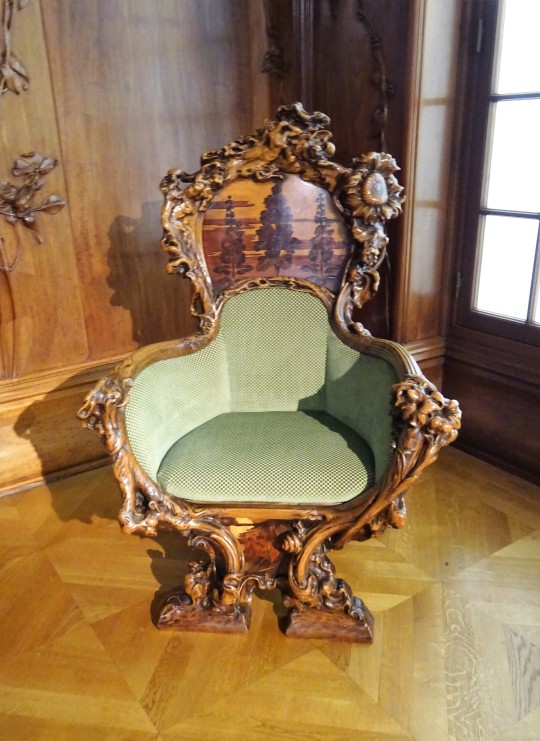
Le jour et la nuit, ~1900 (Day and Night). Georges Rey (apparently). Also "apparently" owned by Sarah Bernhardt
As we weaved in out of the rooms and Terrasse Seine, we moved from furniture that we would love to have in our house, some Salvador Dali type of stuff and a mixture of statues and sculptures from Rodin and other well known artists as well as plenty of little known ones.

Vir temporis acti, Adolfo Wildt
We were finally finished on the northern side, moved across the way and immediately walked amongst the statues on the opposite mezzanine, Galerie Françoise Cachin. Entering into Salle seventy something containing the works of Van Gogh (Dutch post-impressionist psychotic from the late 19th century) and Paul Gauguin, who lived to just after the turn of the twentieth century (French post-impressionist spent last few years of his life in French Polynesia with the locals), we encountered a smorgasbord of two of the greats. The precursor to Starry Night, Starry Night on the Rhone, a Van Gogh self portrait and some lovely paintings of Polynesian locals.
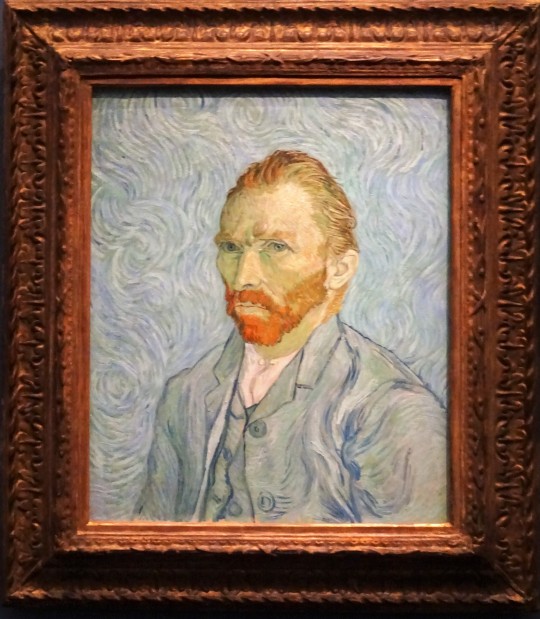
Portrait de l'artiste, Vincent Van Gogh

Femmes de Tahiti ou Sur la plage, Paul Gauguin
To the eastern end of the building was Terrasse Rodin, displaying some of his works, and the stairs down to the ground floor. Terrasse Rodin along with the mezzanines held over sixty of his works, some excellent, some good, some not so good. The stairs to the floor below dropped us straight into a great display of drawings of the opera house and a cut away scale model of the stage and the complicated workings that made the whole operatic experience work.
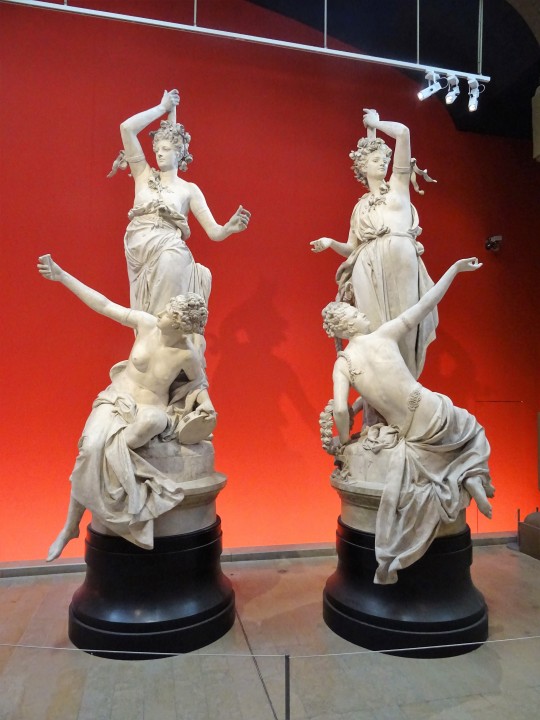
Torchère au tambourin & Torchère à la couronne. Albert-Ernest Carrier-Belleuse
To finish the morning, we headed towards the exit by way of the Allée centrale des sculptures, straight up the centre towards where we came in earlier. Several statues caught our eye, in particular three statues of African dudes in alabaster (we think). The contrast in colours made the depictions very dramatic and very life like. They were impressive to say the least.

Nègre du Soudan, Charles Henri Joseph Cordier
Upon leaving the Orsay we didn't have to travel far for some tucker. In the laneway next to where we entered, on Rue de Lille, was the Royal Orsay Café. We first had a look at the menu and was going to walk away, probably because of the cost, but quickly about faced and went in for a quick refreshment. Next, we headed back across the Seine and into Jardin des Tuileries, turned left and headed down to the Musée de l'Orangerie via Allée Centrale, the wide central path through the gardens.

Resting at Bassin Octogonal. Looking towards Jeu de Paume
Built in 1852 to house the orange trees of the Tuileries Palace during winter, the Orangerie, along with Jeu de Paume, was assigned to the Under-Secretariat of State for Fine Arts after World War I, with the intention of housing an exhibition of living artists. It was at this point, although with one foot in the grave that Claud Monet got a guernsey. Offered to the French State at the conclusion of the war as a symbol of peace. His overly large set of Water Lilies has hung there ever since. This artwork is what greeted visitors, laid out in a circular room with bench seats in the middle facing each of the four separate panels. Each panel showed the changing seasons of the water lily pond at the bottom of Monet’s large garden. He sat down by the pond and worked on the pieces. It took 30 years for him to complete and has been on display in this gallery since 1927

Giving the "illusion of an endless whole, of a wave with no horizon and no shore". Monet's words, not ours
Another impressive display in the Orangerie was an exhibition that was acquired by the French State in the late fifties. It was called the Jean Walter and Paul Guillaume collection and belonged to their surviving wife, Domenica. Paul was a young and very successful French art dealer who prematurely met his demise, according to some at the hands of his unscrupulous wife, dying of an ulcer in his early forties. Apparently, she was nursing him and done a less than successful job. Her next husband, Jean, was a successful architect, not through being good at his trade but by detecting a lode of lead and zinc in Morocco in 1925. Ten years later he founded Société des mines de Zellidja which made him richer. Domenica married Jean in 1941, and he too died suspiciously after being run down by a car. This, with the fact that she hired a hitman to kill her step son led to the scuttlebutt that the State done a deal with her to bequeath her collection or face gaol. Good story, true or untrue. The collection currently comprises of works from Renoir, Cézanne, Gauguin, Monet and Sisley as well as Picasso and Matisse, amongst others.

Maurice Utrillo, La Maison Bernot. 1924
This was an interesting display but it was time to move on, walking back through the gardens to the apartment for an hour. Once rested, we found ourselves looking to some old territory for dinner. Back across Jardin des Tuileries to Arc de Triomphe du Carrousel where the Africans were at it. Shane and Jo walked past and ignored them but they got Thomas with the string around the finger trick. They tie a colourful piece of string around the finger as a trick and when it cannot be removed, they hassle for money as it is "yours". It didn't work though as Jo intervened and hunted them away. As they retreated they yelled out that they were escaping from the "Australian Mumma". Over Pont des Arts, past Cathare, the Treasury building and up Rue de Seine to Bar du Marché for a beer and a feed. As it was, they had no food so after a couple we went shopping around the corner for some food and Jo and Cec taxied it back to the apartment with the groceries while Shane and the boys returned home the long way.

Enjoying Bar du Marché with its wall clad peeling mirrors
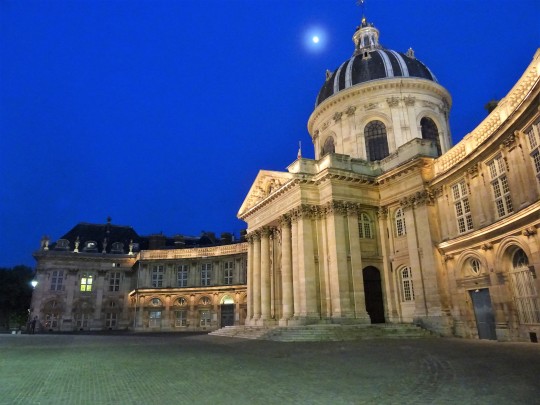
The Treasury Building
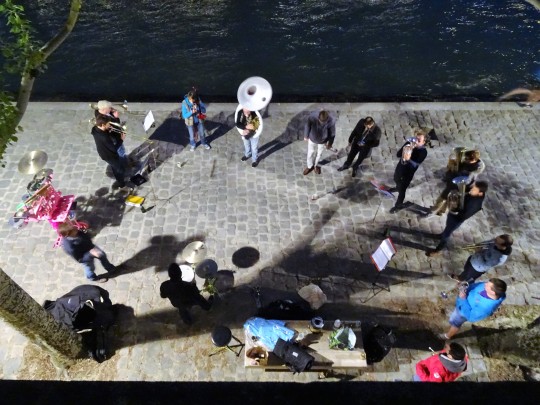
Entertainment below Quai de Conti
What a great day, a home cooked meal and tomorrow, Versailles.
1 note
·
View note
Text
Vysehrad Castle: National Cultural Monument of Prague
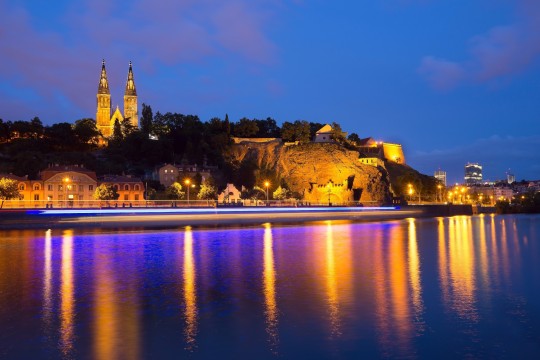
Vysehrad Castle is one of the most important iconic landmarks of Prague directly connected with the history of both the city and Czech nation. In Czech, Vysehrad Castle stands for the upper castle. When you visit the Vysehrad Castle you will see that it is located over a huge rock block. Castle is also known as the Vysehrad Fortress and it is located about 3 km south of the Prague Castle, on the eastern side of the Vltava river. Vysehrad became a national symbol during the 1800s and the Vysedrad Cemetry also became the final resting place for the most famous Cezch. Vysehrad Castle is a bit far away from a couple of popular spots of Prague like Wenceslas Square, Dancing House, Old Town Square and Jewish Quarter (Josefov) but be sure that it is definitely worth to visit. Especially if you want to discover the glorious history of Prague and Cezch nation. Also, don't forget to enjoy the stunning views of the Vysedrads.

An old image of the Vysehrad Castle (Source).
Vysehrad Castle: A Royal Fortress
Based on the historical documents, history of the Vysehrad Castle dates back to the 10th century. We started to see the first information about the castle during the reign of Vratislaus II who was the first King of Bohemia in 1085. The bishop of Prague moved to the seat of the archbishop from Prague Castle to Vysehrad because of endless conflict between him and his little brother, Jaromir. During the reign of King Vraislaus II and his successors Vysehrad was a very important place for Prague. A couple of iconic buildings were constructed on the hill like The Romanesque Basilica of St. Peter and St. Paul and Rotunda of St. Martin. Also, a surrounding wall around the Vyshedrad Castle was built. But from 1140 after the reign of the Vladislaus II, Vysehrad started to lose its importance for the city. Because he moved back the throne to back to the Prague Castle.
During the Roman Reign: Charles IV
From the beginning of the 14th century, The Holy Roman Emperor Charles IV started to build the Prague Castle. At the same, the Vysehrad Castle fully abandoned as a royal seat. But in the following years, whole Vysehrad Castle complex completely removed by the Charles IV with new gates, fortifications and royal palace constructions. During the Hussite wars, Vysehrad invaded and ransacked by Hussites in 1420 and Podebrady King George in 1448. After the war, Vysehrad Castle was abandoned and almost fully ruined, stayed in vain until the 17th century. Habsburg Monarchy took over the Czech and the Thirty Years War, they were totally renowned the Vysehrad Castle in the Baroque way on 1654.
National Symbol of Czech
As a result of changing world, the strategic importance of the Vysehrad Castle faded after the second half of the 19th century. But its meaning and importance for the Czech even became stronger and more important. On this occasion, Václav Štulc and Mikuláš Karlac had enormous effect who were very important writers of Czech history. Because they managed to convert the Vysedrad Castle to a national symbol by stories of Queen Libuse, Czech myths, Women's War and more. Also, the establishment of a national cemetery on the over a ruined one increase the significance of the site in 1893. Since then, most of the important Cezch figures buried there. Today, Vysehrad Castle is the place where the history, culture and myths of the Czech nation meet where is definitely worth to visit. I try to summarize as short as possible the history of Vyhedrad Castle. I know it's quite complicated but also interesting. I'm going to give information about the places in the Vysehrad Castle must visit during your time in Prague.
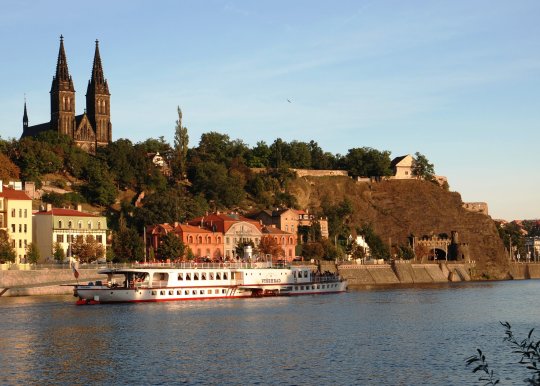
Vysehrad Castle from the Vltava river (Source).
Where is Vysehrad Castle?
As I mentioned at the beginning of the post-Vysehrad Castle is located a bit south of Prague's Old Town Center. It is just located in front of the Smíchovské nádraží train and metro station, on the eastern bank of the Vltava river. It is possible to use the Vyšehradský železniční most pedestrian bridge to pass the Vltava river to go to the Vysehrad Castle. Don't worry it is not too far away to go for you. If you like to walk to discover the cities a great route is waiting for you. Vysehrad Castle is only 3 km away from the Charles Bridge. If you decided to walk you can follow this route. Over the route, you may also see a couple of important places like Clementinum, National Theatre, Jiráskův most, Dancing House and more. For the public transport you can find you options below;
How to Go to The Vysehrad Castle?
Well, my suggestion is to walk. For walking, you can follow the route given above. But if you are thinking to use public transport to go to the Vysehrad you are lucky! Because the castle is located between a couple of major transport line which makes it very easy to go there. Please check below to find detailed information about public transport. Because of its size, it is possible to reach to the Vysehrad from more stops given below but most of the lines follow the same routes around the castle.
Smíchovské nádraží metro station: Line B (Yellow, the western bank of Vltava river)
Vyšehrad metro station: Line C (Red, the eastern side of the castle)
Ostrčilovo náměstí tram station: Lines 2, 3, 6, 7, 14, 17, 18, 21, 22, 24, 92, 93, 95, 98
Výtoň ferry station: P5 line
Visiting Vysehrad Castle: Tours and Tickets
There are a couple of places where you can visit besides the Vysehrad Castle. You can visit Burgrave's Residence, Vysehrad Gallery, Brick Gate, Gothic Cellar, Open-air Theatre and Casemates and Gorlice. However, Vysehrad is a huge open-air park. This is another reason to visit Vysehrad. Because you can walk through the park and enjoy nature, sun and fresh environment. I'm going to give brief information about each place you can visit at Vysehrad Castle in a minute. You can also see all places and helpful information about the Vysehrad on the interactive map below.
The Old Burgrave's House
At the second half of the 14th century, The Old Burgrave's House built during the right of Charles IV as a palace. The Old Burgrave's House is the only palace survived from the Hussite pillaging over the Vysehrad Castle in 1420. The house is reconstruction during the renovation works in the 18th century in Baroque style. However, a more recent renovation hold over The Old Burgrave's House between 2003 to 2005. As a result of this renovation, a cafe and auditorium with 90 seat capacity added to the palace. Also, there is a park for the children at the house. From time to time, different activities organized here for the kids.
Vysehrad Gallery
The gallery building is a former guard tower from the Charles IV reign. Vysehrad Gallery is located over a rock block was the part of the Libuse's Bath. You can find permanent and temporary collections at Vysehrad Gallery focusing on both historical and futuristic features.
The Brick Gate of Vysehrad
In 1841, as a part of the construction of a new road between Tabor to Vysehrad, The Brick Gate of Vysehrad built by the Karel Chotek who was the governor of the Prague. There two pedestrian entrance and one for the vehicle at the Brick Gate of Vhsehrad. Today, the gate is using for an information centre and the main entrance to Casemates. Also, you can take a look at the multimedia projection here about the history of the Vysehrad Castle and the region itself. There is no admission fee to visit the Brick Gate of Vysehrad.
The Casemates and Gorlice
In order to move the military troops faster and efficient the complex system of classmates built under the Vysehrad Castle between the 17th and 18th centuries. In total, the length of the castmates is more than 1 km long. Also, the dimensions of the corridors are 1.5 m wide and 2 m high. The largest part of the castmates called Gorlice. Gorlice is like a simple hall but with a bigger dimension, 13 meters high and 300 square meters area. It used as a gathering hall for the soldiers and storage for the food and weapons during the military threats. However, you can see six of the original statues removed from the Charles Bridge on here. A very extensive renovation during the 1990s held on the Casemates and Gorlice to make it accessible by the public. You can find the names of the six original statues from removes from the Charles Bridge below;
St. Bernard with Madonna by M. V. Jackl (1709)
St. Augustine and St. Nicholas of Torentino (J.B.Kohl, 1708)
St Adalbert (F.M.Brokoff, 1709)
St Anne (M.V. Jäckel, 1707)
St Ludmilla with the Young Wenceslas (M.B.Braun, 1720-24)
Gothic Cellar
The Gothic Cellar is one of the four remained building from the Charles IV reign. The cellar was used as a storage depot of the Vysehrad Castle during the 14th century. Also, historians believe that there were another floor, dining hall and a chapel on the Gothic Cellar. They believe these part of the Gothic Cellar demolished during the Hussite invasion. The ruins of the Gothic Cellar was found during the construction of Baroque Castle. You can visit the permanent and temporary exhibition at the Gothic Cellar.
Open-Air Theatre
As a reaction to the suppressed uprising in Prague on the year of 1848, the open-air theatre was built on the north-western part of the Vysehrad Castle. Cultural activities hold on at the Open-Air theatre of the Vysehrad Castle generally between May to September. Open-air Theatre is also accessible with wheelchairs.
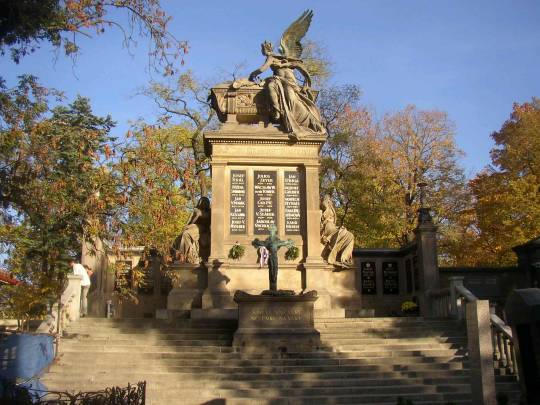
Pantheon located at the Vysehrad Cemetery (Source).
Opening and Closing Hours of Vysehrad Castle
Vysehrad Castle and the other buildings are open during the year. You can find the opening and closing hours valid for Vysehrad Castle, Old Burgave's House, Vysehrad Gallery, The Old Brick Gate of Vysehrad, Casemates and Garlic, Gothic Cellar and Open-air Theatre below. The only exception is the Children's Playground opening and closing hours. Children's Playground is open between 08.00 to 20.00 between May to September and 08.00 to 19.00 between October to April. The Old Czech Legends Playground is located in the small garden on the mound opposite the Rotunda of St. Martin.
Opening Hours
Closing Hours
January-March
09.30
17.00
April-October
09.30
18.00
Vysehrad Castle Tours and Tickets
If you want to visit Vysehrad Castle you can do it by yourself. You need to pay the admission fee for the only the couple of the building inside the Vysehrad. You can buy your tickets directly from the kiosk inside the Vysehrad. It is also possible to join a tour to enjoy the full experience of discovering the Vysehrad. For example if you join the Prague: 2.5-Hour Vyšehrad Castle with Gorlice Tour, you will have enough live guide tour during the whole visit. Tour tickets also include the metro ticket, St. Peter’s and Paul’s Basilica entrance ticket and Vyšehrad Casemates (Gorlice) entrance ticket. If you are looking more tour to visit the Vysehrad Castle and Prague please check the widgets below.
Please share your thought and suggestions on the comment section to help the people who are planning to visit the Vysehrad Castle. Also, feel free to ask your questions. Don't forget to add the Vysehrad Castle and the other iconic landmarks of Vysehrad to your places to see in Prague list.
Read the full article
0 notes
Text
Free to Use and Reuse: Geneaology
Free to Use and Reuse: Geneaology
By Neely Tucker
Published October 14, 2019 at 10:30AM
“Six Generations,” R.W. Harrison, Selma, Alabama. 1893. Prints and Photographs Division.
It’s time once again to dip into our Free to Use and Reuse sets of pictures, culled from the Library’s millions of copyright-free photographs, prints, maps and so on. This month, we’re featuring things that relate to ever-popular genealogy searches, as people look to uncover the secrets of their past by identifying their ancestors and the lives they led. The Library is great for this, offering ways to identify your ancestors, and then help document how and where they lived.
First up is this remarkable photograph of five women and a toddler, taken in Selma, Alabama, in 1893, in the studios of R.W. Harrison. It’s titled “Six Generations,” but there are no names or other identifying information. This prompts a number of questions. Namely, what is the order of birth, and is this all one family? Let’s presume the latter is true. Certainly in that era, when photographs were formal occasions, a family portrait was more likely than not; and, besides, the women certainly appear to be related.
As to order of birth: The toddler is the youngest; it’s reasonable to think that the matriarch is the seated woman in the middle, just to the left of the child. I’d venture that second oldest is the woman seated on the right, in the patterned dress, followed by the woman seated at the far left, in the white dress. In turn, her daughter would be standing, in the black dress at right. The child’s mother, then, would be in the white dress, center. In sum, that’s everyone from the baby of the family to her great-great-great grandmother!
If we assume 20 years between each generation, that would make the eldest somewhere around 100, but it’s certainly possible she could be in her late 80s. Now, putting a historical filter over the image: In 1893, the Civil War was just 28 years in the past. That almost certainly means the oldest four women in the picture were born into slavery, with the eldest born no later than the administration of Thomas Jefferson.
If the toddler remains in Selma (not at all assured, given that the Great Migration began drawing African Americans to northern cities when she will be a teenager), she will be in her mid 60s when Rosa Parks electrifies the nation by refusing to give up her seat on a city bus to a white man in Montgomery, setting off the bus boycott that launched the civil rights movement. A decade later, when she is in her mid 70s, the Selma-to-Montgomery Marches will jolt her hometown into history and will lead to the Voting Rights Act of 1965.
Of such photographs, books are written.
Topographical map of Atlantic County, New Jersey, 1872. Beers, Comstock & Cline, New York. Geography and Map Division.
Perhaps your roots are in Atlantic City, New Jersey, or thereabouts? This 1872 topographical map of Atlantic County is detailed down to the block, with property owners names listed in most places. Atlantic City had a population of 1,043. Not only would this show you where your ancestor lived, it would let you know who lived next door and down the street.
And, finally, an urbane photo from D.C. in 1907. It’s titled “Mr. Chow and Family in Auto,” and pictures a family out for what looks to be a Sunday drive — one child is seated next to Mr. Chow, another in the back with two women. The picture was donated — and possibly taken by— one Barnett McFee Clindist. It is included in a set of 21 small prints that “Includes portraits of government officials and socialites; photo montage of President Wilson and his family… group portrait of automobile manufacturers in automobiles at the White House … montage portrait of the U.S. Supreme Court justices” according the cataloguing data.
It would seem, then, that Mr. Chow is a socialite of some note, possibly, given the political nature of other photos in the set, a diplomat. He’s wearing a spiffy bowler, the car top is down and the dirt road is dry, so it looks like a fine day for a jaunt. Perhaps this is Rock Creek Park? Has one of the children asked, “Are we there yet?” Was that a thing, then? The automobile was such a newfangled invention that the destination may have been immaterial; the point of the afternoon was just the grand experience of your dad puttering you about in his grand motorcar. You could wave to the lesser mortals as you passed. That would likely do just fine.
“Mr. Chow and His Family in Auto.” 1907. Washington, D.C. Donated by Barnett McFee Clinedinst. Prints and Photographs Divison.
Subscribe to the blog— it’s free! — and the largest library in world history will send cool stories straight to your inbox.
Read more on https://loc.gov
0 notes
Text
When Did Republicans And Democrats Switch Ideals
New Post has been published on https://www.patriotsnet.com/when-did-republicans-and-democrats-switch-ideals/
When Did Republicans And Democrats Switch Ideals
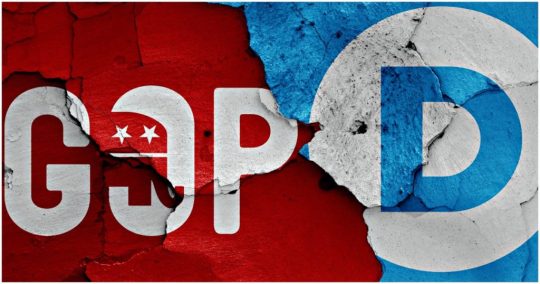
Third Party Part 2: The Industrial Revolution To The Progressive Era
The string of Presidents between Lincoln and Grover Cleveland includes some important stories of know-nothing parties and populist parties , but we cant cover everything here.
Importantly, this era ends with Clevelands second presidency and the Panic of 1893 . Cleveland is a right-wing President, who was very popular and supported by the South, ultimately his downfall, the height of the industrial revolution, and an upcoming war set the stage for more changes in American politics.
TIP: Cleveland is a great example of a true Conservative, he is a Democrat by name, but this Bourbon Democrat is great like an Eisenhower, he should be a model for todays Libertarian who sometimes gets side-tracked by their cousins on the right. The end of his Presidency is arguably more about the changing times than the man.
Gilded Age Politics:Crash Course US History #26. The corruption pointed out in this video starts after Lincoln and continues into the late 1800s and, of course, some of the arguement hasnt gone away. At the very, least figures like Cleveland and Roosevelt do a bit to get politics back on the right track before the upcoming Progressive era .The Progressive Era: Crash Course US History #27. The Progressive era, named due to all the parties embracing progressivism to some extent.
James A Haught Says Teddy Roosevelt Was The Last Republican Liberal And Was Shifting By The Time His Democratic Nephew
Strangely, over a century, America’s two major political parties gradually reversed identities, like the magnetic poles of Planet Earth switching direction.
When the Republican Party was formed in 1856, it was fiercely liberal, opposing the expansion of slavery, calling for more spending on public education, seeking more open immigration and the like. Compassionate Abraham Lincoln suited the new party’s progressive agenda.
In that era, Democrats were conservatives, partly dominated by the slave-holding South. Those old-style Democrats generally opposed any government action to create jobs or help underdogs.
Through the latter half of the 19th century, the pattern of Republicans as liberals, Democrats as conservatives, generally held true. In 1888, the GOP elected President Benjamin Harrison on a liberal platform seeking more social services.
Then in 1896, a reversal began when Democrats nominated populist firebrand William Jennings Bryan , “the Great Commoner.”
“He was the first liberal to win the Democratic Party presidential nomination,” political scholar Rich Rubino wrote. “This represented a radical departure from the conservative roots of the Democratic Party.”
The Progressive platform attacked big-money influence in politics, vowing “to destroy this invisible government, to dissolve the unholy alliance between corrupt business and corrupt politics.”
Here’s how to submit letters and op-eds to the Chronicle
The Civil War Drives Republicans To End Slavery
Ward, Prothero, and Leathes, The Cambridge Modern History Atlas
In the Republican Partys first six years of existence, slavery-related controversies pitting the North against the South grew more and more heated. Free-Soilers fought pro-slavery settlers in Kansas, the Supreme Court ruled in the Dred Scott case that black Americans couldnt be citizens, and abolitionist activist John Brown tried to start an armed insurrection against slaveholders.
Throughout all this, the Republican Party gradually gained strength in the North and in 1860, the party’s victories throughout the region were to win its little-known nominee, Abraham Lincoln, the presidency. Now, Lincoln wasnt the Great Emancipator yet; in fact, he continually promised that he wouldnt interfere with slavery where it existed.
But white slaveholders in the South still didnt want to abide by the rule of the entirely Northern Republican Party. So in 1861, 11 statesseceded to form a new nation, the Confederate States of America. And when Northerners concluded that they could not stand for secession, the Civil War began.
At first, the Norths stated aim was merely to restore the South to the Union not to free slaves. But as the war dragged on, strategic imperatives inexorably pulled Lincoln and the Republicans further toward abolition, as they sought to undermine their Southern opponents.
The Ideology Of Old Republicans And Modern Democrats
was an anti-slavery Republican in his day. In terms of pushing for social justice, using federal power, and taxation his position was similar to todays social liberal.
The and who became the Republicans were often classically conservative in terms of trade, taxes, and general authority. However, factions like Conscience Whigs, , and Radical Republicans worked along with the fact that Republicans were not the Confederate pro-slavery South and drew a lot of progressives in Americas first 100-or-so years especially in the mid-1800s at the height of tension over slavery.
With that noted, we can say the anti-slavery Republicans of Lincolns time roughly held the beliefs of their predecessors the Federalists and Whigs, but also of todays modern Progressives and Democrats.
Compared to their opposition the above major parties are roughly pro-north, pro-banking, pro-federal power, pro-northern factory, and pro-taxes. They favor collective rights over individual rights, typically using Federal power to ensure the welfare of the collective. Thus, they are classically conservative in terms of favoring authority, but liberal in terms of social policy. So they are, as a party, classical conservatives and social liberals .
TIP: See this documentary from 1992 to understand New Democrats.
Last Baseball Game Played At Historic Yankee Stadium


The Dixie Democrats seceding from the Democratic Party. The rump convention, called after the Democrats had attached President Trumans civil rights program to the party platform, placed Governor Strom Thurmond of South Carolina and Governor Fielding L. Wright of Mississippi in nomination.
Up until the post-World War II period, the partys hold on the region was so entrenched that Southern politicians usually couldnt get elected unless they were Democrats. But when President Harry S. Truman, a Democratic Southerner, introduced a pro-civil rights platform at the partys 1948 convention, a faction walked out.
These defectors, known as the Dixiecrats, held a separate convention in Birmingham, Alabama. There, they nominated South Carolina Governor Strom Thurmond, a staunch opposer of civil rights, to run for president on their States Rights ticket. Although Thurmond lost the election to Truman, he still won over a million popular votes.
It was the first time since before the Civil War that the South was not solidly Democratic, Goldfield says. And that began the erosion of the southern influence in the Democratic party.
After that, the majority of the South still continued to vote Democratic because it thought of the Republican party as the party of Abraham Lincoln and Reconstruction. The big break didnt come until President Johnson, another Southern Democrat, signed the Civil Rights Act in 1964 and the Voting Rights Act in 1965.
With The Help Of Liberal Educators And The Liberal Media Democrats Have Been Rewriting History For Decades
Our public schools as well as our colleges and universities have either stopped teaching U.S. Civil Rights History entirely or they teach a revised version in which they chronologically report the good and the bad without attribution. For example, they may report the horrors of the KKK but will not mention that it was the terrorist arm of the Democratic Party or that the KKK often hung Blacks and Republicans together of which many were Black Republicans. Our history books may cover the history of the 13th Amendment to the Constitution, which freed the slaves, without revealing the party associations of those who voted for and against it. In other words, they fail to teach their students the truth.
And the media? In MSNBCs coverage of the 50th anniversary of Democratic Governor and segregationist George Wallaces attempt to prevent the integration of the University of Alabama, the network identified Wallace as R., Alabama. Yes, they really are that dishonest.
The Democrat lies just keep on coming
Racism and the Democratic Party share an ugly past. Now, the accusation of racism and the Democratic Party share an ugly present.
The Most Important Points In Terms Of The Parties Switchings
So much changed it is near impossible to sum up neatly. There are a few important things to note however:
1. There isnt one thing that changed. As time rolled on factions changed parties, political leaders changed parties, platforms changed, regions that had always voted one party switched and began to support another slowly, and over time. Further some of the switches were in response to changing times and platforms and some of the switches led to platforms changing.
3. Although a few notable politicians literally switched parties, that isnt the main thing that happened. What happened was that seats in government in states that used to be held by one party came to be held by the other and regional voters switched parties over time as new officials came into office . Again, this happened to a degree that the voting map looks like it flipped.
4. There were so many major changes in history that historians have a name for them, the party systems. See an overview of the party systems.
5. In general one could say that the Democratic Party became more progressive over time and the Republican Party became more conservative. Both are big tents, but in the past each had a prominent liberal and conservative wing and today each party has become more polarized . So the parties switched in that way as well, and this is notably one of the main reasons factions and voter bases switched.
How Can We Tell What Switched If Anything
If we want to more accurately see what is happening with the parties we have to look at each political, party, faction, and platform in regards to each issue. We can take any issue, from any major American political party platform over time, and see how it compares to other issues of other parties. This can help us see how parties like Federalists, Whigs, Republican-Democrats, Democrats, Republicans, Libertarians, and Progressives did or didnt change over time, and what that means in perspective.
Below is a chart we created showing one way to view the complex political left-right spectrum .
A left-right paradigm using a four point graph to show how common government types relate to left and right in terms of who has authority and who says so.
If one had to place historical figures on the left and right, in terms of the chart presented above , then VERY loosely we might say:
Right Wingers: Hamilton , Cleveland , Hoover, , Reagan
Left Wingers: Jefferson , Lincoln , Teddy Roosevelt , FDR , Johnson
If one had to place historical figures on our more complex 4-point spectrum, then VERY loosely, but more accurately than above, we might say:
Again, we find that party names are spread out over political leanings . From here forward we will focus on telling the history of each Party System in detail, discussing platforms and political views to better illustrate the changes.
Democratic And Republican Ideologies Undergo Dramatic Role Reversal
The Democratic and Republican Parties have undergone a long transition from their founding ideological principles. The started out as the conservative party but are now the liberal party, and the were once the liberal party but are now the conservative party.
The Democratic Party we know today evolved from the conservative Democratic-Republican Party of the 1790’s. The first contested Presidential election was in 1796. The Democratic-Republican Party nominated the conservative Thomas Jefferson as their first presidential nominee. Party members were anti-federalists who favored state sovereignty, free markets, a decentralized federal government, and an originalist interpretation of the U.S. Constitution and the attendant Bill of Rights. The Democratic-Republican Party also supported the institution of slavery.
Democratic President Martin Van Buren presided over the panic of 1837, and during that time he was steadfastly opposed to using the government as a means of employing workers on public works projects. In fact, during this economic depression Van Buren literally sold the federal government’s tool supply so that the government could not use the tools for public works projects. This ideological mindset is diametrically opposite of the economic stimulus proposals that contemporary Democrats now support and advocate for, especially during periods of economic morass.
Party Switching In The United States
In the politics of the United States, party switching is any change in affiliation of a partisan public figure, usually one who is currently holding elected office. Use of the term “party switch” can also connote a transfer of holding power in an elected governmental body from one party to another.
This Is Not A New Argument
Princeton University Edwards Professor of American History Tera Hunter told USA TODAY that this trope is a fallback argument used to discredit current Democratic Party policies.
At the core of the effort to discredit the current Democratic Party is the refusal to accept the realignment of the party structure in the mid-20th century, Hunt said.
In September, NPR host Shereen Marisol Maraji called the claim, one of the most well-worn clapbacks in modern American politics.
Comedian Trevor Noah tackled the misleading trope on an episode of “The Daily Show” in March 2016, after two CNN contributors debated the topic.
Every time I go onto Facebook I see these things: Did you know the Democrats are the real racist party and did you know the Republicans freed the slaves? Noah joked. A lot of people like to skip over the fact that when it comes to race relations, historically, Republicans and Democrats switched positions.
A similar meme attributing the claim to U.S. Secretary of Housing and Urban Development Ben Carson has been on social media since November 2016.
Who started the KKK? That was Democrats. Who was the party of slavery? Who was the part of Jim Crow and segregation? Who opposed the Civil Rights Movement? Who opposed voting rights? It was all the Democrats, the meme reads.
Other posts making more specific claims about the Democratic Party starting the Civil War or founding the KKK continue to circulate.
The Republican Sixth Party Strategy Where The Tea Party And Alt
Everything noted so far leads up to one other thing that needs to be discussed on its own .
After Voting Rights 1965 it wasnt just a matter of switching the South, it was a matter of taking that 1930s conservative coalition to the next level and the Republicans switching themselves .
No social conservative faction was strong enough on its own to win an election, not after Voting Rights, but together, under a strategically planned big tent, the social conservatives and establishment conservatives could create a siren-like Frankensteins monster to push for free-enterprise and socially conservative values against the progressive state an increasingly progressive Democratic Party .
This story involves:
The Powell memo, the southern strategy, the John Birch Society, the repeal of the Fairness Doctrine, Goldwater, Nixon, Reagan, Norquist, Roger Aisle, Lee Atwater, Karl Rove, Fox News, Reagan, Right-Wing Radio, Alex Jones, Rush Limbaugh, and a vast right-wing conspiracy aimed at getting the many different social conservative and establishment conservative factions to adopt each others ideology .
Essentially, the Conservative Coalition in their fight against Communism and liberal democrats since WWI, but especially when their hand was forced post 1965, have created the modern right-wing populist political machine to counter the lefts own political machine .
Republicans And Democrats After The Civil War


Its true that many of the first Ku Klux Klan members were Democrats. Its also true that the early Democratic Party opposed civil rights. But theres more to it.
The Civil War-era GOP wasnt that into civil rights. They were more interested in punishing the South for seceding, and monopolizing the new black vote.
In any event, by the 1890s, Republicans had begun to distance themselves from civil rights.
Adams And The Revolution Of 1800
Presidency of John AdamsThomas JeffersonJohn Adams
Shortly after Adams took office, he dispatched a group of envoys to seek peaceful relations with France, which had begun attacking American shipping after the ratification of the Jay Treaty. The failure of talks, and the French demand for bribes in what became known as the XYZ Affair, outraged the American public and led to the , an undeclared naval war between France and the United States. The Federalist-controlled Congress passed measures to expand the army and navy and also pushed through the Alien and Sedition Acts. The Alien and Sedition Acts restricted speech that was critical of the government, while also implementing stricter naturalization requirements. Numerous journalists and other individuals aligned with the Democratic-Republicans were prosecuted under the Sedition Act, sparking a backlash against the Federalists. Meanwhile, Jefferson and Madison drafted the Kentucky and Virginia Resolutions, which held that state legislatures could determine the constitutionality of federal laws.
The Claim: The Democratic Party Started The Civil War To Preserve Slavery And Later The Kkk
As America marks a month of protests against systemic racism and many people draw comparisons between current events and the Civil Rights Movement, an oversimplified trope about the Democratic Partys racist past has been resurrected online.
Many Instagram users read between the lines for the tweets implication about the modern Democratic and Republican parties. Some argued this past action discredited current liberal policies, while others said it did not matter.
Historians agree that although factions of the Democratic Party did majorly contribute to the Civil War’s start and the KKK’s founding, it is inaccurate to say the party is responsible for either.
The Party Of Kennedy V The Party Of Nixon In The Civil Rights Era
Two things started happening at the same time:
Racist Democrats were getting antsy
Neither party could afford to ignore civil rights anymore
In 1960 Kennedy defeated Nixon. At the time of his election, the both parties unevenly supported civil rights. But President Kennedy decided to move forward.
After Kennedys assassination in 1963, Johnson continued Kennedys civil rights focus.
As you can imagine, that did not sit particularly well with most Southern Democrats. This is when Strom Thurmond flew the coop for good.
In fact, a greater percentage of Congressional Republicans voted for the Civil Rights Act of 1964 than did Democrats. Support for the Act followed geographic, not party, lines.
Photo Credit
Soon after, the Republicans came up with their Southern Strategy a plan to woo white Southern voters to the party for the 1968 election.
The Kennedy and Johnson administrations had advanced civil rights, largely through national legislation and direct executive actions. So, the Southern Strategy was the opposite states rights and no integration.
As in the Civil War, the concepts of states rights and tradition, were codes for maintaining white supremacy.
Starting with Thurmond in 1964, and continuing throughout the Johnson and Nixon administrations, Dixiecrats left the Democrats for the Republicans.
Photo Credit
Dinesh Dsouza Gives An Inaccurate Reading Of The Big Switch Myth: His Version Of History Is A Myth
Dinesh DSouza decided to make a movie about how the Democrats didnt change and how Northern ghettoes are proof of modern slavery .
This argument shows a lack of an understanding of American history .
Northern ghettoes are a problem because lots and lots of reasons . Their problems stem from things like: the nature of capitalism and classism, a push-back against busing and integration, the great migration, immigrant rather than a history of slavery, and even less heartwarming truths of obstructionist factions in both parties .
Northern Ghettoes like South Side Chicago arent a product of the Confederate ideology, they are a product of economic inequality. It isnt because Socially Liberal Progressives and are racist and have racist policies, it is because aristocracy + oligrachy + capitalism + the welfare state = economic inequality for economic minorities .
This is very different than Southern Slavery where the less-thans were known by skin color rather than pocketbook size.
This is to say:
The party with the outwardly hurtful policies is generally the party with the Social Conservatives in it .
The party with the policies that are economically hurtful is typically the business wing of both parties, always. Not all factions of a given party, but generally the dominate establishment factions; as those are always the factions with the most money and thus the ones least likely to create policies that dont help their class first.
We are divided by social issues.
Summarizing The Party Systems As A Two
Current events and complexities aside, there has almost always been a two-party system in the United States. The mentality of each party can be expressed as northern interests and southern interests, although I strongly prefer city interests and rural interests . Sometimes we see both interests in the same party, as with Humphrey and LBJ, and sometimes it is less clear cut, but we can always spot it in any era.
Thus, we can use a simple two party answer as to which held which interests over time, which I hope will be seen as helpful, and not divisive. Remember the U.S. is a diverse Union of 50 sovereign states and commonwealths where the need to get a majority divides us into red states and blue states as a matter of custom, not as enemies, but as a United Republic with a democratic spirit.
Northern City Interests: Federalists, Whigs, Third Party Republicans, Fourth Party Progressive era Republicans , Fifth Party Democrats , Modern Democrats.
Southern Rural Interests: Anti-Federalists, Democratic-Republicans, Third Party Democrats, Fourth Party Progressive Era Democrats , Fifth Party Republicans , Modern Republicans.
TIP: One way to summarize all of this is by saying the changes happened under, or as a result of, key figures including Jefferson and Hamilton, Adams and Jackson, Lincoln, Grant, Cleveland, Bryan, the Roosevelts, Wilson, Hoover, LBJ, and Clinton. See a comparison of the political ideology of each President from Washington to Obama.
A Response To The Claim Welfare Is Equatable To Slavery
In the 1850s, inequality in the Northern big government cities, northern immigration in the big cities , and African slavery in the small government south all existed side-by-side. and in ways, so it is today . Northern cities still favor bigger government, and they still have problems of racism and inequality, Rural South still favors small government . This does not make the North of today equatable to the slave economy of the South of yesterday however.
There is this idea that welfare is equatable to slavery in this respect, as in both cases a societal structure is providing basic essentials for a class of people . This argument, often presented in tandem with the claim the parties didnt switch/change is essentially a red herring that misses the nuances we describe on this page .
The southern conservatives who held slaves and fought for the Confederacy essentially switched out of the Democratic party starting in the 1960s, and even continuing to the modern day , in response to LBJs welfare programs . In other words, if the southern conservative had wanted to oppress a class of people with welfare, one would logically assume they wouldnt have switched out of the Democratic party over time in response to welfare programs.
Today it is a Southern Republican who flies to Confederate flag, today it is a Republican who champions small government in America. Yesterday, it was a Southern Democrat.
The Ideology Of Old Democrats And Modern Republicans
Andrew Jackson was a southern states rights and Jacksonian Democrat, which is similar to todays socially conservative.
Early factions like and the Young America movement were rather progressive. The and War Democrats in the North were non-Confederate conservative factions during the Civil War. A Bourbon Democrat is essentially a Libertarian. Thus, we can say the pro-states rights Democrats of Lincolns time held both the beliefs of their predecessors the Anti-Federalists and Democratic-Republicans, and those of todays modern Libertarians and Republicans.
Compared to their opposition the above major parties are roughly pro-south, pro farmer, pro-state-power, anti-central-bank, anti-debt, and anti-taxes. They tend to favor individual rights over collective rights, typically choosing deregulation over government enforced social justice. Thus, they are liberal regarding authority but conservative in terms of social policy. They are, as a party, classical liberals and social conservatives. Today they might be called , , and .
TIP: Want to understand modern Republicanism? See this documentary on the Tea Party.
0 notes
Text
Vysehrad Castle: National Cultural Monument of Prague

Vysehrad Castle is one of the most important iconic landmarks of Prague directly connected with the history of both the city and Czech nation. In Czech, Vysehrad Castle stands for the upper castle. When you visit the Vysehrad Castle you will see that it is located over a huge rock block. Castle is also known as the Vysehrad Fortress and it is located about 3 km south of the Prague Castle, on the eastern side of the Vltava river. Vysehrad became a national symbol during the 1800s and the Vysedrad Cemetry also became the final resting place for the most famous Cezch. Vysehrad Castle is a bit far away from a couple of popular spots of Prague like Wenceslas Square, Dancing House, Old Town Square and Jewish Quarter (Josefov) but be sure that it is definitely worth to visit. Especially if you want to discover the glorious history of Prague and Cezch nation. Also, don't forget to enjoy the stunning views of the Vysedrads.
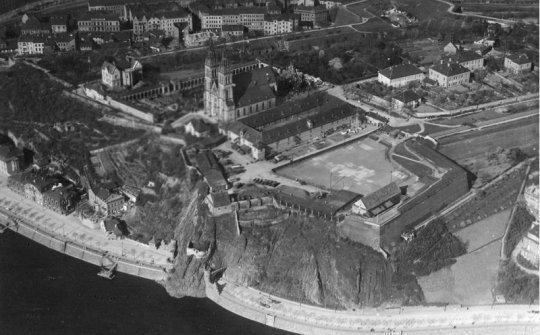
An old image of the Vysehrad Castle (Source).
Vysehrad Castle: A Royal Fortress
Based on the historical documents, history of the Vysehrad Castle dates back to the 10th century. We started to see the first information about the castle during the reign of Vratislaus II who was the first King of Bohemia in 1085. The bishop of Prague moved to the seat of the archbishop from Prague Castle to Vysehrad because of endless conflict between him and his little brother, Jaromir. During the reign of King Vraislaus II and his successors Vysehrad was a very important place for Prague. A couple of iconic buildings were constructed on the hill like The Romanesque Basilica of St. Peter and St. Paul and Rotunda of St. Martin. Also, a surrounding wall around the Vyshedrad Castle was built. But from 1140 after the reign of the Vladislaus II, Vysehrad started to lose its importance for the city. Because he moved back the throne to back to the Prague Castle.
During the Roman Reign: Charles IV
From the beginning of the 14th century, The Holy Roman Emperor Charles IV started to build the Prague Castle. At the same, the Vysehrad Castle fully abandoned as a royal seat. But in the following years, whole Vysehrad Castle complex completely removed by the Charles IV with new gates, fortifications and royal palace constructions. During the Hussite wars, Vysehrad invaded and ransacked by Hussites in 1420 and Podebrady King George in 1448. After the war, Vysehrad Castle was abandoned and almost fully ruined, stayed in vain until the 17th century. Habsburg Monarchy took over the Czech and the Thirty Years War, they were totally renowned the Vysehrad Castle in the Baroque way on 1654.
National Symbol of Czech
As a result of changing world, the strategic importance of the Vysehrad Castle faded after the second half of the 19th century. But its meaning and importance for the Czech even became stronger and more important. On this occasion, Václav Štulc and Mikuláš Karlac had enormous effect who were very important writers of Czech history. Because they managed to convert the Vysedrad Castle to a national symbol by stories of Queen Libuse, Czech myths, Women's War and more. Also, the establishment of a national cemetery on the over a ruined one increase the significance of the site in 1893. Since then, most of the important Cezch figures buried there. Today, Vysehrad Castle is the place where the history, culture and myths of the Czech nation meet where is definitely worth to visit. I try to summarize as short as possible the history of Vyhedrad Castle. I know it's quite complicated but also interesting. I'm going to give information about the places in the Vysehrad Castle must visit during your time in Prague.

Vysehrad Castle from the Vltava river (Source).
Where is Vysehrad Castle?
As I mentioned at the beginning of the post-Vysehrad Castle is located a bit south of Prague's Old Town Center. It is just located in front of the Smíchovské nádraží train and metro station, on the eastern bank of the Vltava river. It is possible to use the Vyšehradský železniční most pedestrian bridge to pass the Vltava river to go to the Vysehrad Castle. Don't worry it is not too far away to go for you. If you like to walk to discover the cities a great route is waiting for you. Vysehrad Castle is only 3 km away from the Charles Bridge. If you decided to walk you can follow this route. Over the route, you may also see a couple of important places like Clementinum, National Theatre, Jiráskův most, Dancing House and more. For the public transport you can find you options below;
How to Go to The Vysehrad Castle?
Well, my suggestion is to walk. For walking, you can follow the route given above. But if you are thinking to use public transport to go to the Vysehrad you are lucky! Because the castle is located between a couple of major transport line which makes it very easy to go there. Please check below to find detailed information about public transport. Because of its size, it is possible to reach to the Vysehrad from more stops given below but most of the lines follow the same routes around the castle.
Smíchovské nádraží metro station: Line B (Yellow, the western bank of Vltava river)
Vyšehrad metro station: Line C (Red, the eastern side of the castle)
Ostrčilovo náměstí tram station: Lines 2, 3, 6, 7, 14, 17, 18, 21, 22, 24, 92, 93, 95, 98
Výtoň ferry station: P5 line
Visiting Vysehrad Castle: Tours and Tickets
There are a couple of places where you can visit besides the Vysehrad Castle. You can visit Burgrave's Residence, Vysehrad Gallery, Brick Gate, Gothic Cellar, Open-air Theatre and Casemates and Gorlice. However, Vysehrad is a huge open-air park. This is another reason to visit Vysehrad. Because you can walk through the park and enjoy nature, sun and fresh environment. I'm going to give brief information about each place you can visit at Vysehrad Castle in a minute. You can also see all places and helpful information about the Vysehrad on the interactive map below.
The Old Burgrave's House
At the second half of the 14th century, The Old Burgrave's House built during the right of Charles IV as a palace. The Old Burgrave's House is the only palace survived from the Hussite pillaging over the Vysehrad Castle in 1420. The house is reconstruction during the renovation works in the 18th century in Baroque style. However, a more recent renovation hold over The Old Burgrave's House between 2003 to 2005. As a result of this renovation, a cafe and auditorium with 90 seat capacity added to the palace. Also, there is a park for the children at the house. From time to time, different activities organized here for the kids.
Vysehrad Gallery
The gallery building is a former guard tower from the Charles IV reign. Vysehrad Gallery is located over a rock block was the part of the Libuse's Bath. You can find permanent and temporary collections at Vysehrad Gallery focusing on both historical and futuristic features.
The Brick Gate of Vysehrad
In 1841, as a part of the construction of a new road between Tabor to Vysehrad, The Brick Gate of Vysehrad built by the Karel Chotek who was the governor of the Prague. There two pedestrian entrance and one for the vehicle at the Brick Gate of Vhsehrad. Today, the gate is using for an information centre and the main entrance to Casemates. Also, you can take a look at the multimedia projection here about the history of the Vysehrad Castle and the region itself. There is no admission fee to visit the Brick Gate of Vysehrad.
The Casemates and Gorlice
In order to move the military troops faster and efficient the complex system of classmates built under the Vysehrad Castle between the 17th and 18th centuries. In total, the length of the castmates is more than 1 km long. Also, the dimensions of the corridors are 1.5 m wide and 2 m high. The largest part of the castmates called Gorlice. Gorlice is like a simple hall but with a bigger dimension, 13 meters high and 300 square meters area. It used as a gathering hall for the soldiers and storage for the food and weapons during the military threats. However, you can see six of the original statues removed from the Charles Bridge on here. A very extensive renovation during the 1990s held on the Casemates and Gorlice to make it accessible by the public. You can find the names of the six original statues from removes from the Charles Bridge below;
St. Bernard with Madonna by M. V. Jackl (1709)
St. Augustine and St. Nicholas of Torentino (J.B.Kohl, 1708)
St Adalbert (F.M.Brokoff, 1709)
St Anne (M.V. Jäckel, 1707)
St Ludmilla with the Young Wenceslas (M.B.Braun, 1720-24)
Gothic Cellar
The Gothic Cellar is one of the four remained building from the Charles IV reign. The cellar was used as a storage depot of the Vysehrad Castle during the 14th century. Also, historians believe that there were another floor, dining hall and a chapel on the Gothic Cellar. They believe these part of the Gothic Cellar demolished during the Hussite invasion. The ruins of the Gothic Cellar was found during the construction of Baroque Castle. You can visit the permanent and temporary exhibition at the Gothic Cellar.
Open-Air Theatre
As a reaction to the suppressed uprising in Prague on the year of 1848, the open-air theatre was built on the north-western part of the Vysehrad Castle. Cultural activities hold on at the Open-Air theatre of the Vysehrad Castle generally between May to September. Open-air Theatre is also accessible with wheelchairs.
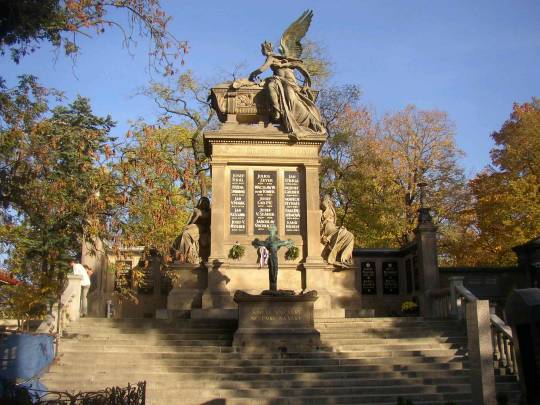
Pantheon located at the Vysehrad Cemetery (Source).
Opening and Closing Hours of Vysehrad Castle
Vysehrad Castle and the other buildings are open during the year. You can find the opening and closing hours valid for Vysehrad Castle, Old Burgave's House, Vysehrad Gallery, The Old Brick Gate of Vysehrad, Casemates and Garlic, Gothic Cellar and Open-air Theatre below. The only exception is the Children's Playground opening and closing hours. Children's Playground is open between 08.00 to 20.00 between May to September and 08.00 to 19.00 between October to April. The Old Czech Legends Playground is located in the small garden on the mound opposite the Rotunda of St. Martin.
Opening Hours
Closing Hours
January-March
09.30
17.00
April-October
09.30
18.00
Vysehrad Castle Tours and Tickets
If you want to visit Vysehrad Castle you can do it by yourself. You need to pay the admission fee for the only the couple of the building inside the Vysehrad. You can buy your tickets directly from the kiosk inside the Vysehrad. It is also possible to join a tour to enjoy the full experience of discovering the Vysehrad. For example if you join the Prague: 2.5-Hour Vyšehrad Castle with Gorlice Tour, you will have enough live guide tour during the whole visit. Tour tickets also include the metro ticket, St. Peter’s and Paul’s Basilica entrance ticket and Vyšehrad Casemates (Gorlice) entrance ticket. If you are looking more tour to visit the Vysehrad Castle and Prague please check the widgets below.
Please share your thought and suggestions on the comment section to help the people who are planning to visit the Vysehrad Castle. Also, feel free to ask your questions. Don't forget to add the Vysehrad Castle and the other iconic landmarks of Vysehrad to your places to see in Prague list.
Read the full article
0 notes